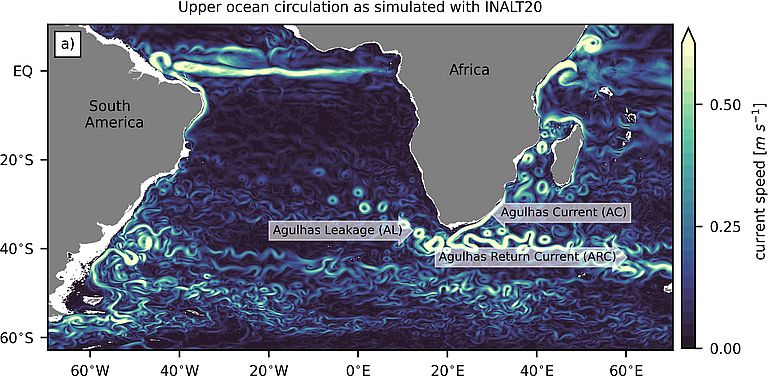The Agulhas Leakage south of Africa holds new surprises
New GEOMAR study investigates decadal variations of Agulhas leakage and their influence on the Gulf Stream system
The Agulhas Current transports warm and salty water from the Indian Ocean southward along the east coast of Africa and forms a retroflection at the southern tip of Africa. From this retroflection, part of the current leaks – among others in the form of oceanic eddies – into the South Atlantic and forms the so-called Agulhas leakage. Through its properties, Agulhas leakage affects the large-scale ocean circulation and global climate, but is also itself influenced by human-induced climate change. Scientists expect that the increase in westerly winds in the southern hemisphere caused by climate change will increase the Agulhas inflow, resulting in increased salt transport into the South Atlantic. This process could counteract the projected weakening of the Atlantic Meridional Overturning Circulation (AMOC) – also called the Gulf Stream system – due to warming and melting of the Greenland ice sheet.
However, changes in the Agulhas Leakage caused by human-induced climate change have so far been difficult to measure and are masked by natural decadal variations. This is the conclusion of scientists from the research unit Ocean Dynamics at GEOMAR Helmholtz Centre for Ocean Research Kiel in a new study published in the journal Nature Communications Earth & Environment. Some of the authors are now doing research at Utrecht University (Netherlands), the University of New South Wales (Australia) and the University of Brest (France).
"Our results indicate that ocean circulation changes in the Southern Hemisphere have already influenced decadal variations in the overall Atlantic overturning circulation," said Dr. Siren Rühs, first author and a physical oceanographer at GEOMAR at the time of the study. "However, the ultimate role that Agulhas leakage will play in climate change remains to be determined," adds Professor Dr. Arne Biastoch, head of the Ocean Dynamics Research Unit at GEOMAR and co-author of the study.
In their study, the researchers combined model simulation and observational data to reconstruct the temporal evolution of the Agulhas Leakage since the 1960s using both established and newly developed methods. These reconstructions reveal that Agulhas leakage very likely increased between the mid-1960s and mid-1980s, consistent with strengthening westerly winds. However, in contrast to previous assumptions, it appears unlikely that Agulhas leakage has continued to increase since the 1990s despite steadily strengthening westerly winds. The model simulations further suggest that the increase in the Agulhas Leakage between the mid-1960s and mid-1980s was accompanied by a strengthening of the AMOC, which spread from the South Atlantic into the North Atlantic. The clear signal is surprising, as the decadal variations in the overturning circulation have previously been attributed mainly to circulation changes in the North Atlantic. According to the researchers, further studies are needed to better understand the natural variations of the Agulhas inflow and to reliably detect and predict human-induced changes.
Original publication:
Rühs, S., Schmidt, C., Schubert, R., Schulzki, T. G., Schwarzkopf, F. U., Le Bars, D., Biastoch, A., (2022): Robust estimates for the decadal evolution of Agulhas leakage from the 1960s to the 2010s. Doi: https://doi.org/10.1038/s43247-022-00643-y
Please note:
This study was funded by the German Federal Ministry of Education and Research under the SPACES-II CASISAC project and by the European Union's Horizon 2020 research and innovation programs (iAtlantic). It also received funding from the Helmholtz Association's Initiative and Networking Fund under the Advanced Earth System Modeling Capacity (ESM) project. Further thanks are due to funding from the DEEPER project of the French National Agency for Research (ANR).



